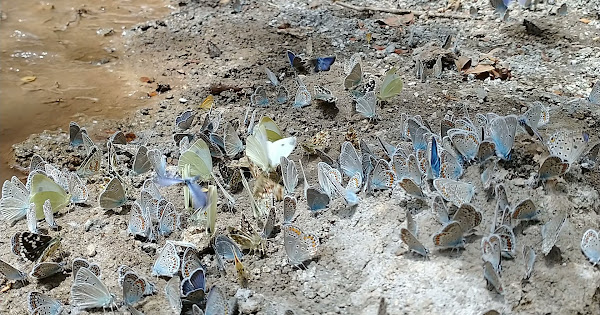28 June. Amberd Valley & Mount Aragats.
Juniper zone on the southern flanks of Mount Aragats, dawn attempt on Radde's Accentor. In a shallow boulder-strewn valley, I began my wanders, Red-backed Shrikes dotting small bushes, Rock Buntings and Black-headed Buntings singing all over, one pair of Ortolan Buntings too. Almost immediately found a pair of White-throated Robins feeding recently fledged young in a gully, then added Ring Ouzels doing likewise. All in all, top class birding, a pair of Barred Warblers also feeding young, several Rufous-tailed Rock Thrushes and both Black Redstart and Black-eared Wheatear. As for Radde's Accentor however, not a peep.
With the sun rising over the peaks though, time to forget Radde's, time to switch back to butterflies. Driving 15 minutes or so back down the mountain, the destination was the Amberd Valley, accessed from Bjurakan village. And as valleys go, this was absolutely phenomenal! A narrow gorge with a gravel track following a stream for several kilometres, it was bucketloads of butterflies all the way - literally thousands and thousands of butterflies at every turn, damp patches attracting mass puddlings of blues, skippers and whites, abundant flowers a magnet for many more species. Within a half hour, I had already seen 30 species, highlights including several Nettle-tree Butterflies and numerous Black-veined Whites (at least 300 during the morning) and Hungarian Gliders (about 120).
It soon became apparent that long periods of the morning would be spent on my belly photographing the puddling butterflies! In other words, nose to nose with endless butterflies of numerous species. Lycaenidae alone numbered more than 20 species, the most numerous being Silver-studded Blues and Common Blues, both in their many hundreds. Adonis Blues and Amanda's Blues also in abundance, plus a rich smattering of others, not least two Eastern Baton Blues, at least three Turkmenistan Zephyr Blues (quite possibly more), my first Mazarine Blues and Turquoise Blues of the trip, one Eastern Brown Argus (and several Brown Argus), a few Pontic Blues and a trio of coppers, specifically Sooty, Small and Purple-shot Coppers. A positive soup of skippers too, Marbled Skippers, Orbed Red-underwing Skippers and Oberthur's Grizzled Skippers leading the way, all three pretty common. In their midst, a couple of Tufted Marbled Skippers, one Inky Skipper, a half dozen Yellow-banded Skippers and several of both Small Skipper and Large Skipper. Aside the blues and skippers, the other main component of the puddling masses were the whites - however, in contrast to most of Armenia where Mountain Small Whites seemed to predominate, the main puddler here was Green-veined White, hundreds congregating in places. A taxonomic note regarding these - the Butterflies of Armenia website doesn't list Green-veined White (Pieris napi) as present in the country, but instead False Small White (Pieris pseudorapae). However, it seems this is now considered synonymous with Green-veined White. Either way, they looked very much like standard Green-veined Whites found across Europe.
Throughout the valley, it was pure pleasure to be among this simple abundance of butterflies. Among the attractions, masses of Painted Ladies and assorted fritillaries (Cardinal Fritillaries, Niobe Fritillaries and Spotted Fritillaries most common, Dark Green Fritillaries, Queen of Spain Fritillaries, Marsh Fritillaries, Knapweed Fritillaries, Glanville Fritillaries, Transcaucasian Fritillaries all in varying numbers), several Large Tortoiseshells and one Yellow-legged Tortoiseshell, four Scarce Swallowtails and one Old World Swallowtail and a whole bunch of browns (two Wall Browns, one Klug's Tawny Rockbrown, one Dark Rockbrown, one Hermit, many Small Heaths, several Pearly Heaths, one Oriental Meadow Brown).
Without much effort, I spent five hours in this valley and in reality could have spent far more. In the early afternoon however, now about 25C, I decided to return to the car at the bottom of the valley for coffee. Yet more puddling butterflies here, these including about 25 Nettle-tree Butterflies and both Commas and Small Tortoiseshells. I had considered further wanderings in the valley, but a barrier a half kilometre up that had previously been unmanned was now manned and the guy didn't seem enthusiastic to allow entry. Potentially access to this site can be problematic.
No real worry, the butterfly delights of Mount Aragats awaited just adjacent. Passed back though the juniper zone, still no Radde's Accentor, then began to make random stops wherever butterflies seemed abundant, a mix of common species seen, plus several Chapman's Blues. Final stop was at the top of the road, just short of 3200 metres altitude, a grass bowl a little beneath Lake Kiri. Very few species this high, but the key one is Bowden's White, a highland specialist that occurs here in its only Armenian locality. Though warm and sunny elsewhere, a stubborn patch of cloud seemed enthusiastic to hog the summit, repeatedly throwing my slopes into shade. When sunny, immediately a few Small Coppers on the wing and plenty of Painted Ladies and Small Tortoiseshells zooming about, a clear migration of the former in progress. Probably was not the best time of day to seek out Bowden's White - all butterflies were highly active and very rarely settling. And that exactly applied to the only white that I saw, a high velocity Bowden's-sized thing vanishing off over rock and scree.
Still, was good for birds - Shorelarks, Water Pipits, Twite and Northern Wheatears. Decided Bowden's White would be easier next morning, so descended again, stopping at some slightly boggy areas to add Blue Argus and Geranium Argus, plus a rather aggressive Armenian Viper. Coiled, ready to strike and intently eyeing me, it was a little beauty nevertheless. Managed to edge in close enough to photograph without getting bitten, then decided to end the day with another walk for Radde's Accentor in the juniper zone. Still nawt.
After the now familiar hour and more evening session of perusing a few of the difficult butterflies, especially the blues and skippers this time, the day's tally settled at 62 species. As for numbers of individuals, many many thousands ...a spectacular day.










 photos.app.goo.gl
photos.app.goo.gl



photos.app.goo.gl






